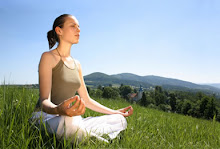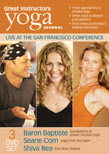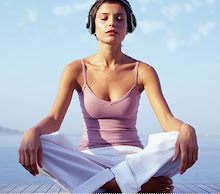Sunday, July 13, 2008
Tuesday, January 22, 2008
Pranayama & Yogic Breathing
.jpg) Pranayama forms a vital step in the path to ascendancy through Yoga.Pranayama is derived from 2 Sanskrit words - Prana (life force) and Ayama (control). Therefore, in its broadest description, Prananyama would mean the control of the flow of life force.
Pranayama forms a vital step in the path to ascendancy through Yoga.Pranayama is derived from 2 Sanskrit words - Prana (life force) and Ayama (control). Therefore, in its broadest description, Prananyama would mean the control of the flow of life force.One of the initiation techniques into Prananyama is through the practice of Yogic Breathing or Yoga Breathing. Yogic Breathing helps us break down and understand our breathing better as being composed of diaphragmatic and thoracic breathing. Although this breathing technique forms a basis to advanced Pranayama techniques, it leads to important benefits of its own and provides us a glimpse of what we are capable of reaching through Pranayama. Yoga breathing can be carried out by lying down on your yoga mat. The "Twintex" yoga mats provide the right snug to give a comfortable yet firm feel that is desirable.
Breathing Components that form the basis of Pranayama
During breathing for Pranayama inhalation (puraka) stimulates the system and fills the lungs with fresh air; retention (kumbhaka) raises the internal temperature and plays an important part in increasing the absorption of oxygen; exhalation (rechak) causes the diaphragm to return to the original position and air full of toxins and impurities is forced out by the contraction of inter-costal muscles. These are the main components leading to Pranayama which massage the abdominal muscles and tone up the working of various organs of the body. Due to the proper functions of these organs , vital energy flows to all the systems. The success of Pranayama depends on proper ratios being maintained between inhalation, exhalation and retention.
Understanding Pranayama
Pranayama works as the basis for spiritual awakening in yoga. Although this is the supreme aim, Pranayama brings about tremendous benefits along the way such as increased energy, increased perception and development of various brain faculties.
Pranayama
To most, control of breath is Pranayama. However, this is a result of wrong interpretation.
For a rightful interpretation, it must be understood that 'prana' is an energy or life force that is universal in nature - it is omnipresent. A portion of that prana is also present in the human body. It flows at a superficial level to maintain the body and its organs.
The goal of Pranayama is to increase the quantum of this life force (Prana) so that it can reach out to 'hidden' recesses of the brain. This helps in expanding the human faculties and retarding degeneration.
How Prana operates?
All the life force or Prana lies as dormant potential energy called the 'pranashakti' or 'kundalini'. It resides at a center which is found just above the genital area, called the 'mooladhara chakra'.
According to yoga, this prana flows from the base 'mooladhara' center up along the right side of the spinal column into the center which lies at the top of the spinal column. This center is called the 'Ajna Chakra'. The prana also gets distributed to the whole body through a different set of nerve channels so that it reaches every atom of the body.
This is how prana operates in the normal body and the scope of Pranayama is to extend this influence beyond the physical body.
Prana and the Brain
Modern science has divided the brain into three parts: the new brain, the middle brain and the primitive brain. According to yoga, the primitive brain forms nine out of ten parts of the brain. These parts are 'silent' and unexplored. The next phase of evolution will see the development of these parts and Pranayama helps achieve that.
Pranayama helps create a greater quantum of prana and also purifies the channels that will carry this increased prana to these 'silent' areas of the brain. It is very important that the channels be purified first to cope up with the increased energy created by Pranayama.
When this fantastic amount of energy is created it flows from the mooladhara through the right side of the spinal column (pingala nadi) and up to the Ajna Chakra. From here it flows into the silent areas of the brain. These are the little known brain areas that house 'mysterious' faculties such as clairvoyance, intuition and expanded awareness.
How Pranayama works?
Through the practices of Pranayama, a certain amount of heat is generated which influences the existing quantum of energy or Prana. For example, if you produce heat in a vessel, it will heat the existing air.
We all have a certain amount of Prana which gives us life and maintains our organs. Pranayama serves to heat that quantum of Prana which then ascends along the spinal column into the Ajna Chakra. When sufficient heat is generated within the system, the Ajna Chakra sends a feedback to the base (the mooladhara) of kundalini and the dormant potential energy is awakened to increase the energy flow to the Ajna Chakra. This is the purpose of Pranayama.
While Pranayama serves to awaken the kundalini, certain Pranayamas are done to purify the carrying channels so that this increased energy can be handled appropriately. For example, the Ujjayi pranayama clears the pingala nadi for the ascension of kundalini.
The science of Pranayama is based on the retention of prana called 'kumbhaka'. Inhalation and exhalation are merely incidental. Those who are serious in awakening the hidden recesses of the brain need to perfect the art of retention (kumbhaka). During kumbhaka there is an increased blood flow into the brain and simultaneously heat is generated in the system.
The heat generates an increased energy in an electrical form. This electrical spark alters the chemical structure of the cerebral fluid which surrounds the brain. When this fluid is chemically influenced, it affects the behaviour of the brain. This is why one experiences a dizziness.
All the great experiences take place in this condition of dizziness. However, it is important that when this occurs you are fully aware. Few people are able to handle it and that is why the practice of Pranayama should be combined with the practice of concentration. When awakening takes place, dizziness occurs and a visual aid is necessary such as a candle, a dot or the 'Om' symbol.
Therefore, the practice of Pranayama has to be done very intelligently and patiently.
Benefits of Pranayama
Patanjali has said that one develops concentration and clarity of thought by practising Pranayama. It helps in increasing the mental and physical powers of endurance. It is the path to deeper relaxation and meditation and is a scientific method of controlling breath. It provides complete relaxation to the nervous system. It provides relief from pain caused by the compression of nerve endings. It helps in increasing oxygen supply to the brain which in turn helps controlling the mind.
src="http://pagead2.googlesyndication.com/pagead/show_ads.js">
Pranayamam
 Pranayamam is essentially a respiration control
Pranayamam is essentially a respiration controlLetting out air is called "Rechaka"; Taking in air is called "Puraka" and holding air inside is called "Kumbaka"
Pranayamam has high place in all vedic rites and is used as a purificatory process. Sages like yagnavalkya, bhodayana have elaborated the greatness of Pranayamam. Manu says that the practice of pranayamam correctly (as detailed earlier) with Vyahrithis, gayathri and gayathri siras, is itself a tapas (austerityor penance) of high order. It purifies the practitioner and purges him of all sins.
Pranayama is used by natural therapists for curing various ailments. According to them, pranayamam helps to control the five basic elements (Fire, etc.) and thus the Bio-electricity.Keeping together (or making contact) of the thumb and first finger of the left hand with the palm facing skywards is also significant. This is known as "meditation mudra". The palm of hand and tips of fingers have chakras. These are capable of absorbing life energy from surroundings. This also helps in respiratory control during pranayamam. Left hand is also known as "amrita hasta" that is a hand with nectar.
Advantages are Absorb, digest and distribute vital energy all over the body. This results in improved health, blood circulation, digestion and other body activities. This also helps to improve memory,sharpness of intellect, mind control, self confidence and many other benefits.
Preserve the functioning of the physical body.
According to our sages, the chakras not only help to maintain a healthy physical body but also help to mould the mind and character of the person. Activation of some chakras result in development of certain pshychic faculties or special powers.
Meditation techniques
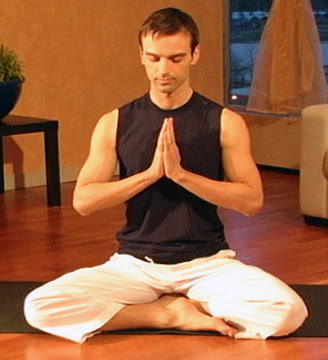 There are numerous methods of practicing meditation. Few of them are as follows :
There are numerous methods of practicing meditation. Few of them are as follows :Breathing Meditation
This is the most easy and direct method of meditation. Taking slow, deep breaths can calm your body and mind in less then minutes. Be quiet, inhale and exhale from the nose slowly and deeply keeping your awareness on the breath. The breath is always with you and you can meditate on it at any place and at any time.
Walking Meditation
When you feel agitated or restless and the thought of sitting itself makes you even more miserable, try this meditation. Walk mindfully for 10 to 15 minutes. Try to harmonize your steps with your breathing. The repetitive motion of your legs and arms helps you to enter a meditative state which takes away the anxiety and anger.
Mantra Meditation
Mantra meditation, also called praying meditation is a good way to comfort you in times of stress and anxiety. Sit in a comfortable meditative pose with eyes gently closed. Keep your back straight and stretched up with shoulders relaxed. Recite silently a pleasant mantra of your choice-Om, Soham, Gayatri, the Serenity Prayer (God, grant me the serenity to accept the things I cannot change, the courage the change the things I can, and wisdom to know the difference) or any other specific one. The mind should be fully focused on the rhythmic flow of the mantra.
Meditation on Thoughts
This is similar to transcendental meditation, TM, the trademark of Mahesh Yogi. Sit comfortably in any meditative posture. Keep your back upright and shoulders relaxed. Close your eyes gently. Concentrate on whatever thoughts come to your mind. Let them come and go without analyzing them. Slowly the thoughts will start disappearing and after about 20 minutes, the mind becomes completely quiet and clam. So, sit in this meditation at least for 20 minutes to feel the effect.
Chakra Meditation
This is an advanced meditative practice in which the concentration is focused on the various energy centres, charkas in the body. Sit in a comfortable meditative posture. Close the eyes gently and breathe slowly and deeply. Feel the breath moving along the spinal column. During inhaling, imagine the breath moving up along the Mooladhara, Swadhisthana, Manipura, Anahata, Vishudhi, Ajna and Sahasrara charka. While exhaling, feel the breath moving down form Sahasrara to Mooladhara charka piercing the various charkas. Adjust your breathing so that by the time you finish inhaling, the attention should reach from Mooladhara to Sahasrara charka. Similarly, your attention should reach from Sahasrara to Mooladhara charka by the time you exhale completely.
One can advance his meditation further after getting some proficiency in its practice. Hold your attention on each charka for as long as you please. Imagine you are breathing in and out from the charka on which you are holding attention. Visualize the important attributes of that charka. Move your attention and breathing from one to the other charka sequentially.
Meditation on Light
Focusing attention on a source of light like a candle or lamp is also a good way of meditation. Keep a burning candle about four feet from you in level with your eyes. Gaze at the candle for as long as you can without blinking the eyes. Now close the eyes gently, and mentally watch the flame of the orange, black, crimson red, etc. When the flame fades away or disappears from your mind, open the eyes and again capture the flame in your eyes. Keep repeating this a number of times till the flames stays bright and steady with your eyes closed.
Image Meditation
In this practice, we visualize some form or image on which we try to hold our attention. This form could be an image of your favourite god or you can visualize anything else that you may like. It may be the picture of a your girlfriend or boyfriend, some interesting and pleasing article-whatever can hold your attention. Sit in a comfortable meditative posture. Keep your back upright and shoulders relaxed. Close your eyes gently and breathe slowly and deeply. Concentrate on the form you have selected. If your mind wanders and shifts away from that form, bring your attention back to it. Practise this meditation for as along as you please.
Meditation In Daily Life
 Meditation should be something that can be carried through into daily life. When life itself becomes a meditation you will be able to concentrate, focus attention on your sitting practice and into other wider things of life.
Meditation should be something that can be carried through into daily life. When life itself becomes a meditation you will be able to concentrate, focus attention on your sitting practice and into other wider things of life.Most of the time our mind is on everything else, except what we are doing. This leads to stress and forgetfulness. Meditation helps us involve our minds in the moment, keeps us away from stress, forgetfulness and getting lost in the distractions of thoughts.
Mindfullness
Our concentration can be improved further by just observing what is happening to us and around us, all the time. This is called mindfulness. Daydreaming is not a negative trait, but you should be aware of what you are doing and shouldn’t simply sink into it.
You can remain mindful, by running a commentary in your head about what you are doing. This helps you to concentrate, become aware and attentive. If you stop one action halfway and start on something else then it will record facts, and later helps you remember where you were in the first action. This running commentary should be done several times a day, for a few minutes at a time. This will train your mind to pay attention to life even when there is no commentary in the head.
Mindfulness helps you to become more effective and organized and continues the process of insight. You become aware even of nature of reality, what it is to be alive, the events in the outside world and our reactions to it.
Distractions in Meditation
You will experience distractions from the start of your meditation. Just sit through and observe whatever you come across during meditation. Only a few meditators ever become free from distractions. The ups and downs in meditation can be a distraction in itself.
What To Do About Distractions
Distractions maybe caused by different types of sounds and noises. Sometimes, bodily sensations like itching in the nose, aching of the hands, irritation in the eyes can also cause distractions. Meditation is not an escape from reality. Distractions both inside and outside the mind are part of that reality, “so simply observe them”, without ignoring or reacting to them.
During meditation unpredictable intrusions, interfere and affect ones meditation and the sound deliberately shatters ones tranquility. But remember if anyone reacts to any sound, then they were not in a state of tranquility. In tranquil state the mind accepts the sound simply.
Yoga Lifestyle - The Eight Limbs of Yoga
 The practice of Yoga does not only focus on physical postures to improve the body, but deals with all the aspects of our being and our lives. C.E., Patanjali who is considered the father of Modern Yoga compiled 195 aphorisms which are called the Yoga Sutra. In the Yoga Sutra, he described the eight aspects of a Yogic Lifestyle and called it the Eight Limbs of Yoga. The limbs are practical guides to a person's personal development to achieve the harmony of the mind, the body and the spirit which leads to Samadhi or enlightenment.
The practice of Yoga does not only focus on physical postures to improve the body, but deals with all the aspects of our being and our lives. C.E., Patanjali who is considered the father of Modern Yoga compiled 195 aphorisms which are called the Yoga Sutra. In the Yoga Sutra, he described the eight aspects of a Yogic Lifestyle and called it the Eight Limbs of Yoga. The limbs are practical guides to a person's personal development to achieve the harmony of the mind, the body and the spirit which leads to Samadhi or enlightenment. Yamas
Yama is your attitude towards others and the world around you. There are five Yamas:
1. Ahimsa or non-violence. This Yama does not only mean not doing harm to others in thought and in deed, but also to practice acts of kindness to other creatures and to one's own self.
2. Satya or truthfulness. Satya is the Yama that is about living a truthful life without doing harm to others. To practice Satya, one must think before he speaks and consider the consequence of his action. If the truth could harm others, it might be better to keep silent.
3. Asteya or non-stealing. This Yama is not only concerned about the non-stealing of material objects but also the stealing of other's ideas and other forms of possession. Using power for selfish motives or telling someone else about confidential information you had been entrusted with is against Asteya.
4. Bramacharya or non-lust. Bramacharya means to move toward the essential truth or to achieve self-control, abstinence or moderation especially regarding to sexual activity. It is about not giving in to our ego's excessive desires or taking nothing in excess.
5. Aparigraha or non-possessiveness. This Yama is about living a life free from greed or taking only what is necessary and do not take advantage of someone or of a situation. It is about using our powers correctly and appropriately and not exploiting others.
Niyamas
1. Ahimsa or non-violence. This Yama does not only mean not doing harm to others in thought and in deed, but also to practice acts of kindness to other creatures and to one's own self.
2. Satya or truthfulness. Satya is the Yama that is about living a truthful life without doing harm to others. To practice Satya, one must think before he speaks and consider the consequence of his action. If the truth could harm others, it might be better to keep silent.
3. Asteya or non-stealing. This Yama is not only concerned about the non-stealing of material objects but also the stealing of other's ideas and other forms of possession. Using power for selfish motives or telling someone else about confidential information you had been entrusted with is against Asteya.
4. Bramacharya or non-lust. Bramacharya means to move toward the essential truth or to achieve self-control, abstinence or moderation especially regarding to sexual activity. It is about not giving in to our ego's excessive desires or taking nothing in excess.
5. Aparigraha or non-possessiveness. This Yama is about living a life free from greed or taking only what is necessary and do not take advantage of someone or of a situation. It is about using our powers correctly and appropriately and not exploiting others.
Niyamas
Niyama is how you treat yourself or your attitude towards yourself. The following are the five Niyamas:
1. Sauca or cleanliness. This Niyama is concerned on both the outer and inner cleanliness. The practice of pranayamas, asanas and Yogic cleansing practices to detoxify and cleanse the physical body are necessary to achieve inner cleanliness. The mind must also be kept clean or pure. Outer cleanliness, on the other hand, means to keep an clean environment or surroundings.
2. Santosha or contentment. Santosha is to practice humility, modesty and finding contentment with what you have and who you are.
3. Tapas or austerity. This Niyama refers to keeping the body in good condition. Tapas is practiced through disciplining the body, speech and mind like eating only when hungry and maintaining a good posture.
4. Svadhyaya or study of the sacred text and of one's self. This involved studying one's self, self-inquiry and self-examination and other things that can help you get to know yourself more. As your knowledge about yourself grows deeper, so is your connection to the higher power and your union with all things.
5. Isvarapranidhama or living with an awareness of the Divine. This Niyama encourages us to let go of our false sense of control and to connect to the Divine or that which gives us the sense of wholeness and sacredness.
Asanas or Physical Poses
1. Sauca or cleanliness. This Niyama is concerned on both the outer and inner cleanliness. The practice of pranayamas, asanas and Yogic cleansing practices to detoxify and cleanse the physical body are necessary to achieve inner cleanliness. The mind must also be kept clean or pure. Outer cleanliness, on the other hand, means to keep an clean environment or surroundings.
2. Santosha or contentment. Santosha is to practice humility, modesty and finding contentment with what you have and who you are.
3. Tapas or austerity. This Niyama refers to keeping the body in good condition. Tapas is practiced through disciplining the body, speech and mind like eating only when hungry and maintaining a good posture.
4. Svadhyaya or study of the sacred text and of one's self. This involved studying one's self, self-inquiry and self-examination and other things that can help you get to know yourself more. As your knowledge about yourself grows deeper, so is your connection to the higher power and your union with all things.
5. Isvarapranidhama or living with an awareness of the Divine. This Niyama encourages us to let go of our false sense of control and to connect to the Divine or that which gives us the sense of wholeness and sacredness.
Asanas or Physical Poses
The Asanas are designed to free our mind and body from tension and stress. It relaxes, rejuvenates, and energizes the body and aims to bring the body and the mind into a harmonious union. Asanas should be done with comfort, ease, alertness and steadiness, achieving a balance between ease and effort.
Pranayama or Breathing Exercises
Pranayama or Breathing Exercises
Pranayama is the control of breath. The breath is regulated and controlled through the practice of breathing exercises. The duration of inhalation, retention, and exhalation of breath is regulated with the aim of strengthening and cleansing the nervous system and increasing a person's source of life energy. Pranayama practice also makes the mind calmer and more focused.
Prathayara or Withdrawal of the Senses
Prathayara or Withdrawal of the Senses
This occurs during meditation, pranayama or asana wherein you are so focused and immersed on your Yoga, Meditation or Breathing Pose that you become unaware of outside situations. Your focus becomes inward and you are no longer distracted by outside events.
Dharana or Concentration
Dharana or Concentration
Dharana is training the mind to focus without any distraction. To achieve this, you can focus your mind into an object at a time. This can also serve as a preparation for meditation.
Dhyana or Meditation
Dhyana or Meditation
Meditation is the practice by which there is constant observation of the mind. It means focusing the mind on one point, stilling the mind in order to perceive the Self. It is an uninterrupted flow of concentration aimed to heighten one's awareness and oneness with the universe. It is also an important tool to achieve mental clarity and Health.
Samadhi or Enlightenment
Samadhi or Enlightenment
This is the ultimate goal of the Eight Limbs of Yoga. It is characterized by the state of ecstasy and the feeling that you and the universe are one. It is a state of peace and completion, awareness and compassion with detachment.
The practice of Yoga does not only deal with developing the body but also covers all the aspect of a person's life as stated in the Eight Limbs of Yoga. It is concerned about the physical, mental and spiritual well-being of an individual as well as his environment and relationship with other creatures. Real practice of these eight principles leads to deeper self-knowledge, love and respect towards other people and creatures, cleaner environment, healthy diet, and union with the Divine.
Yoga Poses & Yoga Exercises
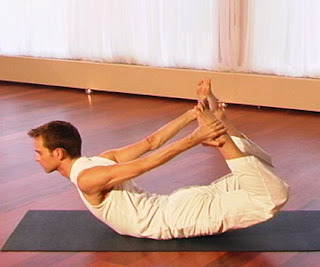 In Sanskrit, the word “pose” is “asana” (pronounced as “ah-sah-nah”). Each asana helps you become more aware of your body, mind, and environment. While beginning your yoga exercises, experiment with the poses, moving in and out as you feel comfortable. If you approach the poses with playful curiosity, feeling of frustration and competitiveness will not enter your mind. While practicing your yoga exercises, make sure that you don’t feel any discomfort or pain.
In Sanskrit, the word “pose” is “asana” (pronounced as “ah-sah-nah”). Each asana helps you become more aware of your body, mind, and environment. While beginning your yoga exercises, experiment with the poses, moving in and out as you feel comfortable. If you approach the poses with playful curiosity, feeling of frustration and competitiveness will not enter your mind. While practicing your yoga exercises, make sure that you don’t feel any discomfort or pain.Yoga Poses and breathing
Breathing is an essential part of practicing yoga exercises. You should never hold your breathe during a pose. Also make sure that your breath is never forced or strained. Labored breathing is sign that you you’re working too hard and should come out of the pose slightly. When one starts practicing yoga, one can hold for three full breaths through most yoga poses. If you feel comfortable in the pose, hold for longer, if uncomfortable, you should come out of the pose immediately.
Types of Yoga Poses
Seated poses – Seated poses are useful for practicing breathing exercises and relaxation or meditation techniques. Seated poses are also often used as a warm up or as a starting point for other poses. Performing seated poses can help improve your posture and open your hips.
Standing poses – Standing poses are often used as warm up or as a starting point for other poses. Standing poses are beneficial for strengthening your legs, opening your hips and improving your sense of balance.
Inversions – Inversions are excellent poses to perform to improve your blood circulation, quiet your mind and improve your overall health. Inversions are also believed to reverse the ageing process and reduce the effect of the gravity on your body
Relaxation and restorative poses – It is important to take time to perform relaxation or restorative poses at the end of each yoga practice. You can use this time to relax your body and mind and allow energy released by the poses in your practice to move freely throughout your body.
Counter poses – A counter pose is a pose that stretches your spine in the opposite direction from a previous pose or returns your spine to a neutral position.
Twists – You can perform twists to stretch and strengthen your back and abdominal muscles, increase the flexibility of your spine and improve your circulation. Twists improve the functioning of your internal organs by providing them with a fresh supply of blood as you twist and release your body.
Balancing poses – Balancing poses are great for improving your balance and coordination as well as developing your ability to remain grounded in a pose. Keeping your body balanced encourages you to focus, quiet and balance your mind.
Forward bends – Forward bends stretch the entire back of your body, especially your hamstrings. Forward bends are also often used to release tension, calm your mind and soothe your nervous system. Similar to back bends, forward bends help keep your spine strong and supple.
Back bends – Back bends are among the most challenging poses in yoga. Bending backward helps strength your back and keep your spine strong and supple. Back bends also open the front of your body, especially your chest.
Subscribe to:
Posts (Atom)
 Meditation (Dhyan) means -
"Full concentration of the mind focused on one of those experiences" In simple terms the spontaneous concentration of the mind on the object is Meditation....
Meditation (Dhyan) means -
"Full concentration of the mind focused on one of those experiences" In simple terms the spontaneous concentration of the mind on the object is Meditation....